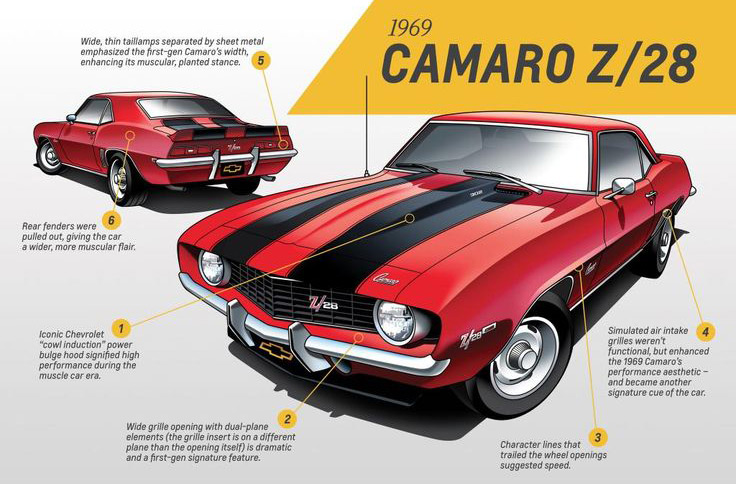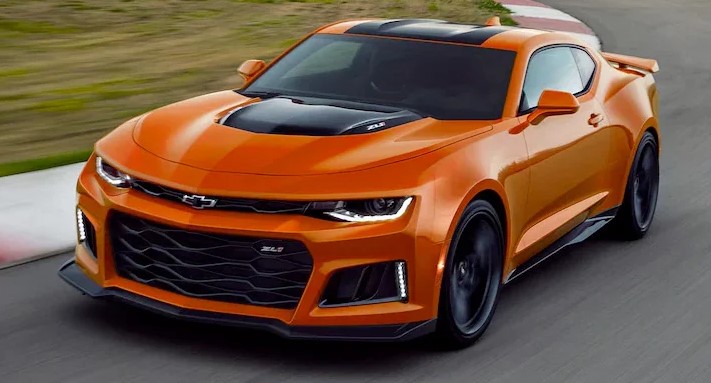The Chevrolet Camaro has always been more than just a car—it’s a symbol of American power and performance. Today, while it’s been infused with the latest technology and features, its spirit and ethos remain true to its storied heritage. This look at the present-day Camaro ponders over this unique blend of legacy and innovation, revealing how respecting its roots has played an integral role in shaping its advanced capabilities. Buckle up, as we take a drive down memory lane, while seamlessly gliding into the future with the Camaro.
Table of Contents
Camaro: A Brief History

The birth of the Chevrolet Camaro in 1967 was nothing short of an automotive landmark. Launched at a time when American appetite for muscle cars was surging, the Camaro was Chevrolet’s answer to the rival Ford Mustang’s roaring success. The initial design and performance bore a striking resemblance to its competition, while still managing to carve out its own distinctive identity in the market. Soon, this sprightly pony car turned into an icon of raw American power and speed.
Over the years, the Camaro has undergone significant transformations, each generation revealing not just advancements in design and technology but also in the public sentiment of their times. The second-gen models (1970-1981) saw a shift from compact, crisp lines to a wider, more streamlined look reflecting a more luxurious attitude. This generation also had the misfortune of struggling through the oil crisis, forcing it to trade its power-driven design for fuel efficiency demands.
By the time the third generation rolled out on the roads (1982-1992), aerodynamics had found its way into Camaro’s concept. The result was a lighter, more streamlined model with improved fuel economy, supported by a more performance-focused design.
The fourth-gen models (1993-2002) embraced the tech revolution, integrating digital dashboard, keyless entry, anti-lock brake technology, and many more cutting-edge comforts.
After lying dormant for eight years, the Camaro made a comeback in 2010. Paying homage to the original first-gen model, the fifth-gen Camaros combined retro styling with modern performance elements, recapturing the love of both the new and loyal enthusiasts. This was followed by the current sixth-gen models (2016-present), that have managed to keep the core elements of Camaro’s muscular personality, with an extra dash of finesse and refinement.
Moving through the course of history, the Camaro has evolved—as all classic cars do—without diluting its quintessential spirit. Across multiple epochs, with different appetites and demands of speed, design, and performance, the Camaro stands tall today as much more than its origins. It’s not just about the race against Mustang anymore – the Camaro has a heritage it proudly carries forward, consistently offering a blend of nostalgia, innovation, and the sheer joy of driving.
Heritage Inspired Design

The spark of heritage often thrums through the best modern designs, and the Chevrolet Camaro is no different. In its crafting, designers have managed to wield nostalgia deftly without being trapped by it. The Camaro is a spirited mix of American muscle cars’ robust lineage, blended with the impetus of the future. Through observing the Camaro’s countenance, the memories aroused are those of epochal yesteryears when horsepower ruled the avenues and lanes.
What sets apart the Camaro is that it breathes vitality into a classic shape without merely replicating it. Combining the stirring cues from the past with a forward-thinking design methodology, designers have held onto the Camaro’s essential, aggressive character. Take, for instance, the latest iteration’s side profile. It oozes the visual tenacity of the original Camaro, evident in its long hood, sweeping fastback, and menacingly short deck. However, a look underneath this classic silhouette unveils an ultramodern aerodynamic design that ascertains it stays grounded in today’s era.
It’s in the unmistakable wide, squat posture and broad shoulders that the hints of the first-generation Camaro echo most vibrantly. The same stance radiates through the recent versions as well, yet it pounces forward with modern lines and windswept flow – a silent, powerful nod to the heritage without becoming a prisoner of it.
The interior design follows suit, alluding to the Camaro’s heritage through a contemporary reinterpretation of the past. With gauges in square housings reminiscent of the 1969 model, it invokes a powerful sense of nostalgia. Meanwhile, flat-bottom steering, touchscreen entertainment system, and ultra-modern technology juxtapose the old with the new, embodying the amalgamation of age-old heritage with the demands of the modern driver.
By balancing retro echoes with cutting-edge innovation, the Camaro steps into the future while clutching, with a firm, respectful grip, the robustness of its past. This delicate balance is what makes the Camaro not just a piece of machinery but a slice of living, roaring American history reimagined for the 21st century. The resulting product sparkles in stunning continuity with what made the original Camaro a beloved classic – not by copying it, but by cherishing its spirit and adapting it for a new era.
Modern Features in Camaro

One aspect where the contemporary Camaro truly shines is in modern features. Today’s Camaro has embraced the digital age with gusto, presenting a rich array of modern technologies all integrated neatly within its muscle-car soul. At first glance, its tech integration might evoke skepticism from purists. However, much like the integration of the vintage design elements into a modern aesthetic, incorporating advanced technologies is also a triumphant homage to its lineage. After all, Camaros of yore have always been about performance innovation.
The current Camaro lineup introduces a 10-speed automatic transmission option, featuring shift times rivalling those of dual-clutch systems. This is a significant step away from the 4-speed in the 60s and 70s models, and a clear indication of how far automotive technology has advanced. However, it also pays homage to the Camaro’s longstanding reputation for pushing the envelope.
The interior experience of today’s Camaro is governed by the Chevrolet MyLink system, offering an 8-inch touchscreen with customizability similar to a smartphone. It’s like having a mini command center at your fingertips. The screen provides access to apps, music, navigation, and system settings. Meanwhile, Apple CarPlay and Android Auto guarantee seamless smartphone integration, allowing you to stay connected, entertained, and focused on the road ahead.
Another highlight of modern features is the driver mode selector, allowing you four distinct driving experiences – Snow/Ice, Tour, Sport, and Track. This, supplemented by other performance-oriented tech such as Magnetic Ride Control and Brembo brakes, brings out a level of versatility that adapts to your driving preference or conditions.
The safety technologies of the Camaro also get a contemporary upgrade. Modern driver-assist features such as forward collision alert, lane keep assist, and rear cross-traffic alert are available for the Camaro to keep you and your ride safer on the road. This reinforces the Camaro’s commitment to deliver thrilling experiences on the road without compromising on safety.
In sum, while the Camaro has traveled a long way from its first-generation roots, it has done so by adapting and incorporating the best of modern technology. The Camaro of today is no simple reincarnation, but a complex character knitted with threads of evolution in automotive technology, road safety, and customer preferences. It is a perfect blend of heritage and avant-gardism, a testament to Chevrolet’s commitment to keeping the Camaro legacy alive in the modern age.
Integration of Old and New in Camaro

In the DNA of the Chevrolet Camaro, one can unmistakably trace a fine balance, a tantalizing dance between the old and the new—a careful integration that works to both preserve its rich and storied past, whilst pushing into the future that automotive new-age technology permits.
On one hand, it’s in the distinctive lines and curves of the body, the familiar throbbing power of the engine, the slight growl waiting to rip into a roar, that the Camaro pays homage to its iconic lineage. Its design takes us on a nostalgic trip, holding on to the fierce, untamed spirit of the Mustang’s perennial challenger from the golden age of American muscle cars.
On the other hand, Camaro isn’t afraid to innovate, to lean into the advancements of the 21st century. Far from a museum piece, it’s a modern beast, fitted with refined ergonomics, a plethora of high-tech features, and contemporary performance specs that meet and even surpass its contemporaries. The cockpit-style layout of the interiors with touchscreen infotainment, advanced safety features such as blind-spot monitoring, and the inclusion of performance enhancing technologies like the Magnetic Ride Control—it all shows that the Camaro has not been left in the rear-view mirror of time.
In essence, the Camaro is unmistakably a product of evolution, not revolution. It weds the past and the present in a seamless union, taking the best from both the eras, proving, once again, that old-school cool can be reinvented, not merely replicated. We see, in real time, retro styling intersect with modern functionalities: the lean, mean attitude of the 1967 model meeting the sleek, sports-car sophistication of today.
In this duality, in this balancing act of a design and performance brief, the Camaro stands apart on the auto landscape. And it is here, in this ceaseless evolution—this integration of the past within the present—that the phrase “what’s old is new again” takes on a whole new layer of meaning. It doesn’t just reflect the timelessness of an iconic marque, but also its readiness to keep stride with the dynamic landscape of automotive technology.
FAQs
Why is the Chevrolet Camaro often associated with heritage?
How does the Camaro’s heritage influence its modern features?
What are the iconic elements reminiscent of older Camaro models in the modern ones?
Conclusion
Although the Chevrolet Camaro has experienced many changes since its debut in 1966, it has not lost connection with its heritage. Modern features like top-notch performance technology and a luxurious interior have been cleverly intertwined with those traditional styling cues that defined the model’s early years. We see the might of the original model reflected even in the six-generation Camaro – a testament to Chevrolet’s understanding of the importance of heritage. After all, these are the idiosyncrasies that have made the Camaro become an automotive icon.
